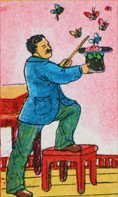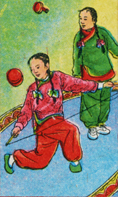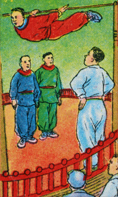by Jean-Michel Guy
The cultural circus cannot be approached globally via the three axes used above (form, aesthetic and function) even though each of its components could potentially be thus analysed.
We will look rather at the deep similarities that unite this type of circus to the classic and contemporary show genres and forms beginning with that of a "cultural form," in the anthropological sense, as conceived by western thought (from this point of view, the Chinese acrobatic theatre constitutes a borderline case as it blends centuries old village traditions with an "Olympic" political model of excellence and borrows from western, now global forms). We can therefore define this "circus world" which does not necessarily recognise itself in the word "circus" thanks to the following three constants:
1. The existence of universal figures such as handstands. Certain of these (juggling, swinging over a void) are, in the West, "supernatural" in the figurative sense, but they are sometimes genuinely perceived as such in numerous places around the world. The comedy figure of the clown also seems to be universal, as this art of clumsiness enables children everywhere to symbolically take revenge on their educators.
2. The rarity of these practices, which means they have to be recognised as abnormal everywhere, which leads to questions about the norm or the absolute.
3. The marginal aspect, on a social level, of these disciplines and those that practice them. Whether initially military (Shaolin monks), religious (Mongolian contortionists), ceremonial (Tongan jugglers) or fun (juggling meets), the practices that resemble the circus arts (and the carnival) are marked as unusual, supervised, marginalised and "parked" in places and schedules that avert any potential excesses.







